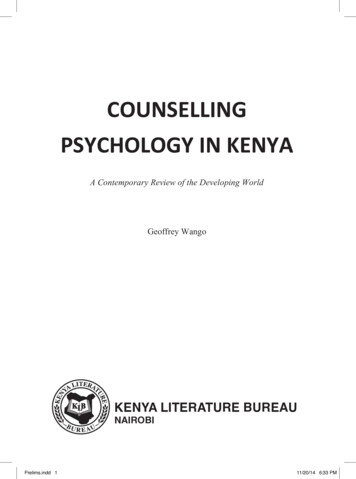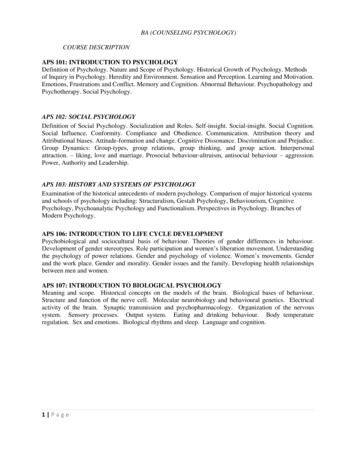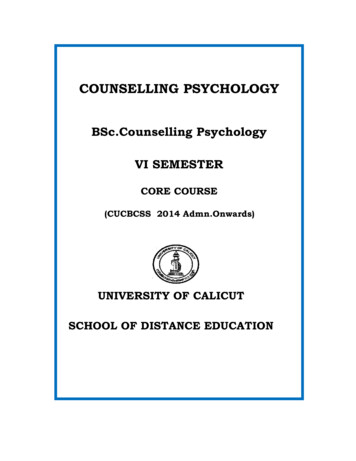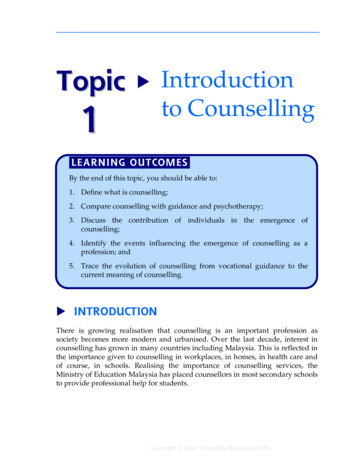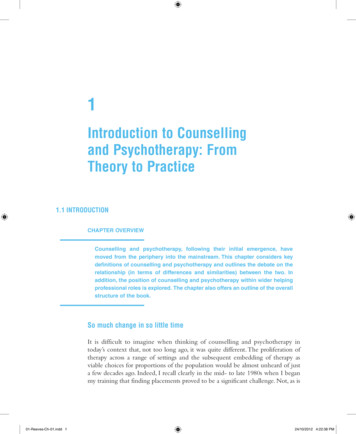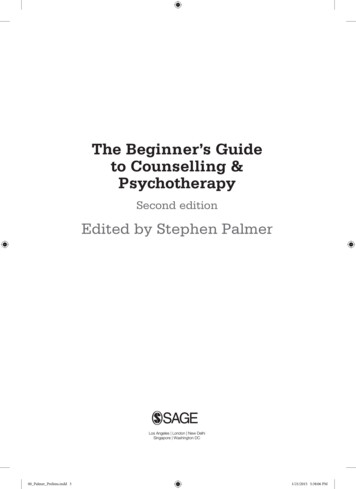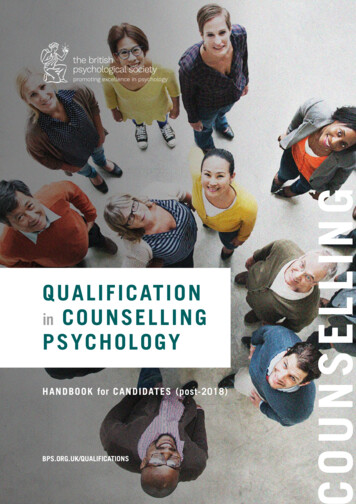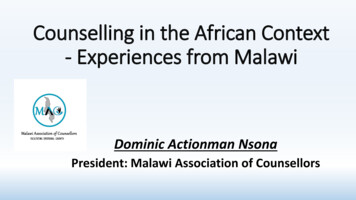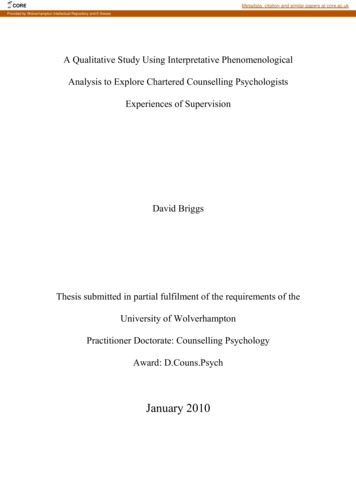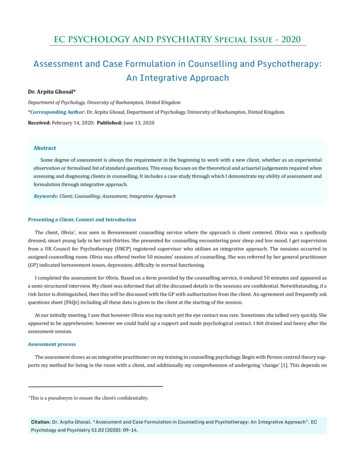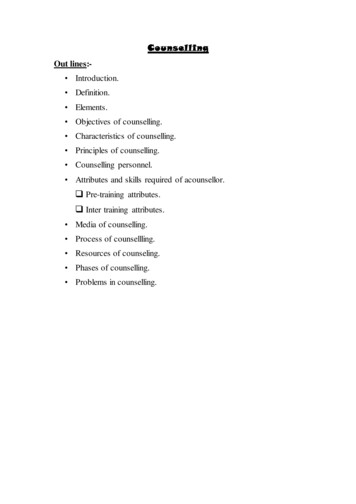
Transcription
CounsellingOut lines: Introduction. Definition. Elements. Objectives of counselling. Characteristics of counselling. Principles of counselling. Counselling personnel. Attributes and skills required of acounsellor. Pre-training attributes. Inter training attributes. Media of counselling. Process of counsellling. Resources of counseling. Phases of counselling. Problems in counselling.
CounsellingIntroduction:Counselling denotes 'giving of advice' it is the relationship betweentwo personnel or the interaction between the counsellor (i.e; oneprofessionally trained worker) & the counselle (ie; the person who seeksthe services or who requires help from the skilled person to resolve hisproblems by finding new ways).DefinitionCounselling is helping processes where one person gives his /hertime, attention and skills to assist a client to explore the situation& mangeStress and that facilitates inter personal relationshipsamong client, family a health care team.Elements of counseling:Counselling involves two individuals:1-Counsellor:- A professionally trained person who can assist the counselle. He should be friendly and cooperative with counselle. He should have through experience and sound knowledge withcounselling process.2-Counselle:- A person who seeks help or needs assistance. He should have trust and confidence over the counsellor. Mutual respect and satisfactory relationship should beestablished.Objectives of counselling:1)To help the client to accept actual or impending changes that areresulting from stress, it involves psychological, emotional, andintellectual.
2)To encourage the client to examine the avaible alternatives decidechoices are appropriate and useful for problem solving.3)To relieve distress among people who are reacting to difficultcircumstances.4)To change the behavior by reducing the stress or risk.5)It helps the counselee to acquire independence & sense ofresponsibility.6)It helps the client to explore and fully utilize his potentialities andactualize him self.7)To encourage & develop special abilities and right attitudes.8)To assist the student in planning for educational & vocational choices.9)To help student to work out aplan for solving his difficulties.10)To help student to grow explore & maintain or develop their overallpersonality.11)To help student in checking wastage and stagnation.12)To minimize the incidence of indiscipline.13)To motivate the students for self employment.Characteristics of counselling It is a purposeful learning experience for the counselle. It is the purposeful oriented and private interview between thecounsellor and counselle. Based on mutual confidence satisfactory relationship will beestablished. Counselling process is structured around the felt needs of thecounselle. Main emphasis in counselling process is on the counselle'sselfdirection& self-acceptance.
Principles of counselling Made to the requirement of an individual's problems Emphasizes thinking with the individual. Avoid dictatorial attitude. Maintain relationship of trust and confidence with the client. Client's need is to be put first. Every one participating in the counselling process must feelcomfortable. The client's family members must be included in counsellingprocess. Skills of warmth, friendliness, and empathy are ingredients ofsuccessful counselling process. Counsellor hastolistenattentively,answerquestionsobjectively. & reinforce important information. Let the client make voluntary informed decision. Maintain dignity of individual is primary concern in counseling.Counseling personnel1)Principal/tutor/medical super intended:-for the counselling programto succeed the support of these persons are essential. Theyrecognize the need for the program, provide facilities finance,coordinate with other members of the staff, give publicity to theprogram and evaluate the counselling program.2)Teachers are the key professionals in the school/college setting.3)Parents: as the counseling program extends beyond nursing school,parents must be told about the need & scope of counsellingprogram.4)Counsellor: the nursing schools may arrange to have them, tell theyhave their own counsellors.
Attributes & skills required of a counsellor:Pre-training attributes Self-awareness & understanding Objectivity. Good psychological health. Trust worthiness. Open- mindedness. Approachability.Inter –training attributes Interview setting & getting started. Physical arrangement: chairs should face each other, withlearning facility for both. Greeting: a warm friendly greeting facilitare the helpingprocess. Maintain eye contact. Demonstrating proper body posture. Problem focus. Identifying an important theme. Directing the theme towards a goal. Managing interaction with the individual. Restatement. Interpretation. Managing pauses and silence.Characteristics of counsellor:1-Interpersonal relationship:- Attentive listener. Fairness. Ability to maintain confidentiality.
Patience Sensitivity to the attitude of people. Friendly nature Sympathetic understanding. Sincerity Speaks in client's language. Tolerance power. Show careful concern& listens the complaints of the client.2-personal adjustment: Aware about one's limitations. Flexibility & adaptability. Able to accept criticism. Maintain emotional stability Able to tolerate ambiguity. Show self confidence.3-health&personal appearance: Freedom from annoying mannerisms. Pleasing voice. Vitality& in durance. Pleasing appearance.4-leadership: Ability to stimulate& lead others. Have a high sense of morality. Reinforce important information. Directs the counselle to the way to solve problems& guide himto choose appropriate one with his own decision (voluntarymanner).
Media of counselling: Regional centers. Study centers. Phone. Face to face contact. Interview. Letters. Audio-video cassette. Conference. Computers. Radio. TelevisionThe process of counselling: Counselling varies from situation to situation. It is a process initiated by the client or the student who is havinga problem. It is a two way interaction between aprovider&the client. Assist the client to accept the reality.Steps: Are appreviated in (GATHER): G: Greet the client. A: Ask about themselves. T: Tell the client or give information. H: Help the client to choose the method. E: Explain how to use the method. R: Return for follow up.Supportive behavior:A) Verbal behavior: uses languages which are understood by the client.(Clear)
C: clarify. L: Listen A: Acknowledge. E: Encourage. R: Reflects&Repeat.B) Non-verbal behavior: uses tone of voice similar to that of the client.(ROLES) R: Relax. O: Open& approachable. L: Lean towards client. E: Eye contact. S: Smile& set comfortably. Occasionally nod the head. Maintain suitable distance.Phases of counselling:1)Establishing relationship.2)Assessment.3)Setting goals.4)Intervention.5)Termination& follow-up.1-Establishing relationship: It is the core phase in the process of counselling. It includes each factor as: respect, trust&sense of comfort. Begin the phase with adequate social skills: Introduce yourself. Listen attentively& remember the client's name. Always address the individual by his preferred name. Ensure physical comfort.
Don't interrupt the individual while he is talking. Observe non-verbal communication.2- Assessment: In this phase individuals are encouraged to talk about theirproblems. Counsellor asks questions, collects data, observes& helps theclient to clearly state his problem. This is the data collecting phase. It involves several specific skills as: Observation. Inquiry. Making association among facts. Making educated guesses. Recording data should be done systematically&promptly.3-Setting goals: To provide direction to individual& counsellor. It helps us to know how well counselling is working& whencounselling is concluded. It requires: Differentiation. Teaching individual to think realistically. The skills of drawing inference.4-Intervention: After setting goals the question that follows is:" How shall weaccomplish those goals?" The intervention used will depend on the approach used by thecounselor, the problem& the individuals.
The counseling skills needed are: Skills in handling interventions, knowledge of its effects& abilityto read client's reactions.5-Termination&follow up: It must be done without destroying the accomplishments gained. It should be done without sensitivity, intention& by fading. Hence termination should be planned over few sessions. Follow up appointments can also be fixed.Resources of counselling: Medical services :( a counselor can refer pupils for specialexamination or treatment. Mental health services :( as psychiatric hospitals). Social welfare agencies :( as youth club, sports club& agenciesto pupils having social or financial problems). Law enforcement agencies. Parent-teacher associations.problems in counselling: Resistance to counselling. Counselee with different cultures. Counselee with strong emotions as: anxiety& depression whichcan hinder counseling process. Lack of awareness of value of counseling by the public. Lack of physical facilities, non-availability of time &tools,dearth of training facilities for counselors. Inadequate administrative setup.
Counselling Introduction:-Counselling denotes 'giving of advice' it is the relationship between two personnel or the interaction between the counsellor (i.e; one professionally trained worker) & the counselle (ie; the person who seeks the services or who requires help from the ski
